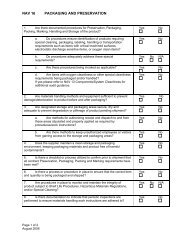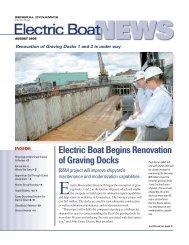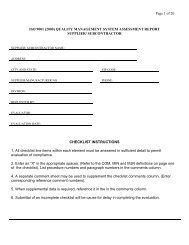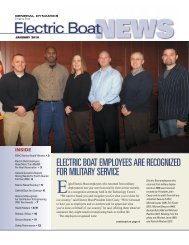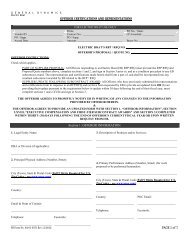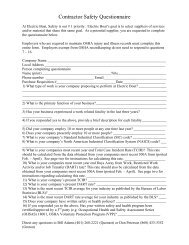Facilities Electrical Subcontractors Safety Manual - Electric Boat ...
Facilities Electrical Subcontractors Safety Manual - Electric Boat ...
Facilities Electrical Subcontractors Safety Manual - Electric Boat ...
Create successful ePaper yourself
Turn your PDF publications into a flip-book with our unique Google optimized e-Paper software.
FACILITIESELECTRIC SUBCONTRACTORSSAFETY MANUALGENERAL DYNAMICSELECTRIC BOAT CORPORATIONJune 28, 2011**All changes as of this date are noted in red.1 of 9
June 28, 2011Table of Contents1. Requirements2. Tools3. Test Equipment4. Personal Protective Equipment5. <strong><strong>Electric</strong>al</strong> Transformer Substation Access6. Equipment System Tagout7. <strong>Safety</strong> Grounding Of Circuits8. Working On Energized Systems9. Barriers10 Confined Spaces11 <strong><strong>Electric</strong>al</strong> Systems And Equipment12 <strong><strong>Electric</strong>al</strong> Work Procedures13 <strong><strong>Electric</strong>al</strong> Shock14 Cardio Pulmonary Resuscitation (CPR)Attachments:<strong>Electric</strong> <strong>Boat</strong> Corporation <strong>Safety</strong> <strong>Manual</strong> # C14<strong>Safety</strong> <strong>Manual</strong> C-14.pdf<strong>Electric</strong> <strong>Boat</strong> Corporation <strong>Safety</strong> <strong>Manual</strong> # F18F-18.pdf<strong>Electric</strong> <strong>Boat</strong> Corporation Shipyard Standard Procedure 7.487.48.pdfReference:Contractor <strong>Safety</strong>, Health and Regulations <strong>Manual</strong>2 of 9
June 28, 20111. REQUIREMENTS1.1. All contractor personnel expected to work on electrical equipment or systems mustread this <strong>Safety</strong> <strong>Manual</strong>, including all referenced material and <strong>Electric</strong> <strong>Boat</strong>Corporation <strong>Safety</strong> <strong>Manual</strong> - Numbers C-14 and F-18 prior to working at <strong>Electric</strong> <strong>Boat</strong>Corporation (EBC), and annually thereafter.1.2. Contractor shall submit to <strong>Facilities</strong> Engineering (D502) a statement signed by allpersonnel expected to work on electrical equipment or systems that they have read,understood, and will comply with this <strong>Safety</strong> <strong>Manual</strong>, including all referenced materialand <strong>Electric</strong> <strong>Boat</strong> Corporation <strong>Safety</strong> <strong>Manual</strong> - Numbers C-14 and F-18. Thisstatement must be submitted before persons are allowed to perform any work at EBC,and annually thereafter.1.3. Contractor shall submit names of personnel qualified to work on low voltage (less than600 volts) electric equipment or systems, and why they are qualified. Submittal shallbe on company stationary and be signed by an authorized individual. Submittal mustbe received by <strong>Facilities</strong> <strong><strong>Electric</strong>al</strong> Engineering prior to person working at EBC.1.4. Contractor shall submit names of personnel qualified to work on high voltage (greaterthan 600 volts) electric equipment or systems, why they are qualified to work on highvoltage, summary of past work experience on high voltage, qualifications to work onhigh voltage, and training qualifying them to work on high voltage. Submittal shall beon Contractor stationary and be signed by an authorized individual. Submittal must bereceived by <strong>Facilities</strong> <strong><strong>Electric</strong>al</strong> Engineering prior to person working on high voltageat EBC.1.5. All work must be performed per OSHA, The National <strong>Electric</strong> Code, ConnecticutBuilding Code, <strong>Electric</strong> <strong>Boat</strong> Corporation Contractor <strong>Safety</strong>, Health and Regulations<strong>Manual</strong>, and this <strong>Safety</strong> <strong>Manual</strong>. If a conflict exists, use the more stringentrequirements.3 of 9
June 28, 20112. TOOLS2.1. Use tools for only the job they are intended.2.2. Maintain tools in good operating condition. Damaged tools shall be removed from thesite and replaced. Foremen and/or EBC Representatives have authority to condemntools.2.3. All contractors must use GFCI protection for portable electrical tools or an assuredequipment grounding program (29 C.F.R. 1926 404 b 1), at all exterior locations,industrial areas, or whenever extension cords are used.3. TEST EQUIPMENT3.1. Test equipment shall be used in accordance with the manufacturer's instructions.3.2. Modification of test equipment is prohibited.3.3. Never use equipment above the equipment's rating.3.4. Carefully inspect all test leads for damage before use. If the leads are damaged removethem from job site immediately and replace. Never repair or modify test equipmentleads.3.5. Never assume test equipment is working, always check for proper operation.4. PERSONAL PROTECTIVE EQUIPMENT(PPE)4.1. Personal Protective Equipment (PPE) must meet the minimum performance standardsestablished by OSHA, <strong>Safety</strong> or Industrial Hygiene, be readily available, be properlymaintained and its use enforced. Personnel are to be properly trained in the use ofpersonal protective equipment. PPE includes such items as safety glasses, hard hats,grinding shields, hearing protection, electrical gloves, flash suits, etc.4.2. Contractor supervision is to ensure its employees are aware of and understand alllimitations and precautions regarding safety equipment and protective clothing and isresponsible for strictly enforcing the proper use of such equipment and clothing.4.3. See the Contractor <strong>Safety</strong>, Health and Regulations <strong>Manual</strong>.4 of 9
June 28, 20114.4. ELECTRICAL GLOVES4.4.1. See <strong>Electric</strong> <strong>Boat</strong> Corporation <strong>Safety</strong> <strong>Manual</strong> - Number F184.4.2. Wear proper gloves for the work you are doing. Know and follow the regulationsand instructions on the use of gloves.4.4.3. Gloves must be rated for or above the class of voltage being worked on.4.4.4. Avoid splinters, burrs and other sharp objects that might puncture gloves. Leathergloves will be worn over rubber gloves if a puncture exposure exists.4.4.5. Never wear rings, watches, etc. when using electrical gloves.4.4.6. Store gloves as recommended by the manufacturer and OSHA.4.4.7. Gloves must be tested annually as a minimum.4.4.8. Properly inspect gloves for damage and leaks before using. If the gloves aredamaged or leak, do not use. Remove gloves from job site.5. ELECTRICAL TRANSFORMER SUBSTATIONS ACCESS5.1. Access is controlled; see <strong>Electric</strong> <strong>Boat</strong> Corporation <strong>Safety</strong> <strong>Manual</strong> - Number F-18,Procedures “High Voltage Area With No Exposed High Voltage Bus Work orConnections” and “High Voltage Areas With Exposed Bus Work and Connection”.6. EQUIPMENT/SYSTEM TAGOUT6.1. Never operate equipment with a "Danger-Do Not Operate" tag. See <strong>Electric</strong> <strong>Boat</strong>Corporation <strong>Safety</strong> <strong>Manual</strong> -Number C-14 and Number F-18.6.2. Once a lockout/tagout procedure has begun for any specified circuit or system, theprocess must be followed through to completion without interruption.7. SAFETY GROUNDS - PERSONNEL PROTECTION7.1. All high voltage equipment, substation, switchgear, and distribution transformers mustbe safety grounded with equipment, rated for the available short circuit current, beforestarting work. All low voltage equipment should be grounded whenever possible, withequipment, rated for the available short circuit current, before starting work. Thisgrounding is for safety of the personnel working on the equipment.7.2. Grounds should be attached on both sides of where personnel will be working.7.3. Equipment shall be discharged before securely attaching grounds. Discharging shall beaccomplished with a hotstick and grounding assembly. A grounding assembly for thelocation shall be first clamped to a grounding electrode conductor, grounded steel orother ground. Then the grounding assembly shall be placed on all phases, closestphase first, with a hot stick. Proper electrical personal protective equipment (PPE) (i.e.electrical gloves, hard hat, safety glasses, face shield, etc.) must be worn.7.4. The hot sticks must always be held away from the body.5 of 9
June 28, 20117.5. Capacitors on a system require special attention. The load rated disconnects must beopened first, then allow ten minutes for the capacitors to discharge through their builtin discharge resistors before grounding to the above procedures.8. WORKING ON ENERGIZED SYSTEMS8.1. See <strong>Electric</strong> <strong>Boat</strong> Corporation <strong>Safety</strong> <strong>Manual</strong> - Number F-18 “Work on energizedcircuits including troubleshooting, will be performed to the following criteria”.8.2. Follow all OSHA and NFPA-70E requirements.8.3. Where proper PPE when working, switching, troubleshooting, etc.9. BARRIERS9.1. Barriers (red tape) shall be used to enclose areas where work, such as the following isbeing performed:9.1.1. Work on or near energized equipment9.1.2. Testing with high voltage (all areas will be at high voltage potential).9.1.3. Work being done in manholes.9.2. Only personnel actually doing the work may enter an area where work is being doneon energized circuits or high voltage testing is being performed.9.3. Only qualified personnel may enter an area with barriers.9.4. Barriers (red tape) shall also be used to isolate areas with energized circuits within awork station, when work is being performed only on de-energized circuits. This isused to remind personnel that all circuits in the area are not de-energized.9.5. Work areas created by the use of barriers must be large enough to allow all necessarywork to be done inside the area with proper equipment. Remember these barriers areto isolate you from external hazards and to keep unqualified/untrained personnel awayfrom a hazard condition.10. CONFINED SPACES10.1. Never enter an uncertified/unposted tank or confined space ( Note: A manhole, vault,or underground tunnel is a confined space.). See <strong>Electric</strong> <strong>Boat</strong> Corporation <strong>Safety</strong><strong>Manual</strong> - Number F-18 “Entry Requirements to High Voltage <strong><strong>Electric</strong>al</strong> UtilityManholes/Vaults”. See <strong>Electric</strong> <strong>Boat</strong> Corporation Shipyard Standard Procedure #7.48.11. ELECTRICAL SYSTEMS AND EQUIPMENT6 of 9
June 28, 201111.1. All non-current carrying components (enclosures, raceways, frames, etc.) must begrounded.11.2. Fuses rated for proper voltage, amperage, and classification must always be used.Never modify a fuse or fuse holder.11.3. All equipment must be rated for the voltage and amperage it is being used for.Equipment must also have a short circuit withstand rating sufficient for theequipment's location in the system.11.4. All equipment must be properly installed. Jury-rigging and/or improper installationsare prohibited.11.5. Green wire shall be used for equipment grounding, ground bonding conductors, orstatic grounding conductors.11.6. All substations, panelboards, circuit breakers, disconnect switches, etc. must beproperly labeled with voltage, equipment being supplied, and the electrical systemdesignation.12. ELECTRICAL WORK PROCEDURES12.1. All circuits shall be assumed "LIVE" until tested. The proper procedure includeschecking the tester on a known live circuit, checking the circuit to be worked on, andrechecking the tester on a known live circuit. The test shall be done at the work site,not at a remote site.12.2. Before working on a circuit breaker with charging springs, make certain the springsare discharged.12.3. Always use circuit breakers to interrupt/open or energize/close circuits under loadswhenever possible. Switches rated for load switching may be used to interrupt/open orenergize/close circuits under loads.12.4. Never remove high voltage fuses when energized.12.5. Always remove fuses with proper fuse pullers.12.6. Always wear proper PPE when opening or closing high voltage switches. Stand to theside of the switch.12.7. Always wear proper PPE and stand to the side when opening or closing low voltageswitches and circuit breakers.12.8. Use only insulated listed (UL or FM) ladders.7 of 9
June 28, 201112.9. Never work on or near energized electrical circuits while standing in water. Manholeswith water should be pumped and cleaned of all mud and water12.10. High voltage cables shall not be cut unless it has been verified to be de-energized. Thecable shall be visually traced from the source and checked with an approved cabletracer (known to be working) at the location to be cut. Tic tracers will not work onshielded cable. A cable insulation piecing tool, properly grounded and operated with ahot stick must be used to verify the cable is de-energized.12.11. All equipment must be grounded. Equipment without proper grounding is a potentialkiller. Jury rigs and improper procedures are simply the practice of fools. Ifindividuals from other trades disconnect leads or violate some other safety practice inignorance of the effect, they are guilty at least of misconduct. If an electrician shoulddo the same thing, he or she is potentially guilty of negligent homicide. There is noexcuse for not knowing the proper practice, or the potential results of failing to followproper practices.12.12. Plugs and connectors shall not be disconnected while under load. Plugs and connectors50 amperes and greater shall not be connected or disconnected while the line isenergized. Open the disconnect means first.12.13. Disconnect switches, panelboards, circuit breakers, etc. shall be accessible at all times.Do not block. A minimum of three feet clearance is required.12.14. All wiring systems shall be permanent in accordance with applicable codes.Temporary wiring shall be used only for emergency use or during construction,remodeling or repairs and shall be a grounded system.12.15. Breaker Rack-in shall be per OSHA requirements and shall be done only with breakersdesigned for this procedure and in accordance with the manufacturer's instructions.Prior to racking-in any circuit breaker, all barriers and doors shall be properlyinstalled. This includes closing and securing the door in front of the breaker, iforiginally provided with the substation. Only the small access for the cranking wrenchshall be open while racking-in the breaker. Circuit breaker enclosures in the vaults onGraving Docks #1 and 2 do not provide barriers between the circuit breaker and thebuss, also the front door can not be closed while racking-in the breaker. Therefore as aminimum the following addition procedures must be followed. 1)Breakers shall beracked into only de energized busses, even if the entire substation must be secured.2)Breakers in contact with energized buss shall not be operated with the front coveroff, or only partially secured, while personnel are in the vault.13. ELECTRICAL SHOCK8 of 9
June 28, 201113.1. See <strong>Electric</strong> <strong>Boat</strong> Corporation <strong>Safety</strong> <strong>Manual</strong> - Number F-18 “Treatment for <strong><strong>Electric</strong>al</strong>Shock”.14. CARDIO PULMONARY RESUSCITATION (CPR)14.1. Each contractor shall ensure that at least one person is trained and certified toadminister CPR at each individual work site. The contractor shall also ensure thatpersonnel designated as CPR qualified shall be recertified on an annual basis.14.2. See <strong>Electric</strong> <strong>Boat</strong> Corporation <strong>Safety</strong> <strong>Manual</strong> - Number F-18.9 of 9




